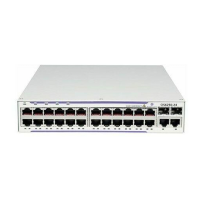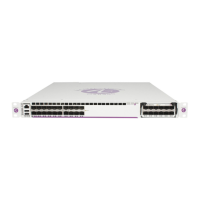QoS Policies
7210 SAS D, E, K OS Quality of Service Guide Page 23
Overview of QoS Policies on 7210 SAS-K
On 7210 SAS-K QoS policies are applied on service ingress, service egress and access uplink
ports (ingress and egress) and define the following:
• Classification rules for how traffic is mapped to forwarding classes
• Forwarding class association with queues.
• Queue parameters for shaping, scheduling and buffer allocation
• QoS marking/interpretation
There are several types of QoS policies:
• Service ingress (for access SAP ingress)
• Service egress (for access SAP egress)
• Network (for access-uplink port ingress and egress)
• Network queue (for access-uplink port egress)
• Slope policies (for all queues)
• Remark policies (for both access SAP egress and access-uplink port egress)
• Dot1p and DSCP classification policies (for access SAP ingress and access-uplink port
ingress).
Service ingress QoS policies are applied to the customer-facing Service Access Points (SAPs) on
access ports. Traffic that enters through the SAP is classified to map it to a Forwarding Class (FC)
and the user has an option to also assign a profile on SAP ingress. Forwarding class is associated
with queues on SAP ingress and the profile determines the enqueuing priority for the packet, with
in-profile packets having a higher chance of getting a buffer, than out-of-profile packets. The
mapping of traffic to queues can be based on combinations of customer QoS marking (for
example: IEEE 802.1p bits, IP DSCP bits). The characteristics of the forwarding class queues are
defined within the policy as to the number of forwarding class queues for unicast traffic and BUM
(Broadcast, Unknown-unicast, and Multicast) traffic along with the queue rate and buffer
parameters (like CIR, PIR, CBS, MBS). Each of the forwarding classes can be associated with
different parameters for unicast traffic and different parameters for multipoint (that is, BUM)
traffic. A service ingress QoS policy defines up to 8 queues per policy, with up to 2 queues (that is,
Unicast Queue Mapping and Multicast Queue Mapping) per forwarding class. Unicast and
multipoint traffic can be mapped to use the same queue or mapped to use different queues per
forwarding class with a maximum of up to 2 queues per forwarding class, one each for unicast and
for multicast traffic. In the case of VPLS service, four types of forwarding are supported (which is
not to be confused with forwarding classes), unicast, multicast, broadcast, and unknown.
Multicast, broadcast, and unknown types are flooded to all destinations within the service while
the unicast forwarding type is handled in a point-to-point fashion within the service. All these
traffic types use the same multicast-queue mapping defined for forwarding class. In other words, a
separate queue for multicast, broadcast, and unknown unicast traffic types cannot be defined.

